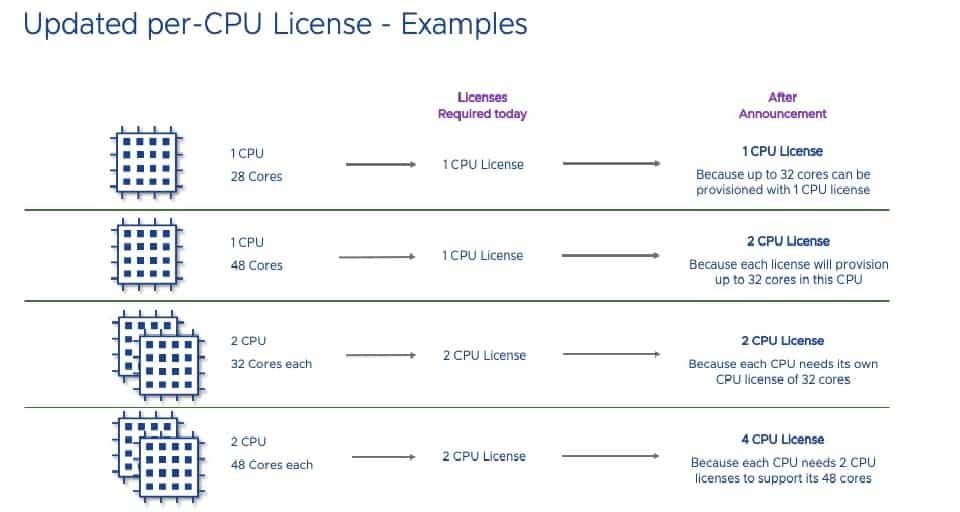A VMware anunciou uma mudança significativa em seu licenciamento por CPU. Toda esta mudança entrou em vigor no dia 02 de abril de 2020.
Lembrando antes de qualquer análise técnica que a empresa nunca se preocupou com o número de núcleos em cada CPU e então deve ser o último dos grandes fabricantes a manter uma métrica de processador por CPUs físico. A maioria deles já mudou para licenciamento usando fatores e índices mais complexos para cálculo das licenças requeridas.
Esta mudança pode gerar impactos na forma como sua empresa provisiona ambientes, nas infraestuturas de TI e principalmente como planeja a adoção de nuvens hibridas. Um planejamento sem levar em consideração nuvens públicas ou recursos como VMware Cloud on AWS poderá dobrar o custo do licenciamento de CPU para clientes com mais de 32 núcleos.
Mas o que mudou?
Em casos de processadores rodando VMware com menos de 32 núcleos, nada muda. Caso estes tenham mais de 32, será necessária uma licença extra para as próximas 32 e licenças adicionais para cada bloco subsequente de 32.

Sabemos que a AMD e Intel já possuem chips com até 64 núcleos, mas provavelmente não vai demorar muito tempo até que estejamos falando de 96 ou até mesmo 128 CPUs. Vale ressaltar que AWS, Google e Azure já disponibilizam instancias com 96 vCPUs.
Como posso me beneficiar dessa mudança no licenciamento VMware agora?
A VMware está fazendo uma mudança gradual e sem custos imediatos, mas para ter este “benefício” você precisa tomar algumas decisões e ações rápidas! Caso nao faça as alterações agora, os custos fatalmente chegarão em 2021.
Clientes com CPUs acima de 32 núcleos por chip podem solicitar licenças adicionais gratuitas via revendedor ou diretamente com a VMware.
Eu poderei usar este “benefício” se:
- Fizer a solicitação formal do benefício até 29 de janeiro de 2021;
- Se meus servidores e as licenças foram comprados antes de 30 de abril de 2020. Guarde todos os documentos de aquisição de hardware e software seguindo as regras de Software Asset Management.
- Tenho um contrato com SNS (VMware Technical Support and Subscription Services) ativos nas licenças originais e contratado antes de 30 de abril de 2020.
O ônus deste benefício é que quando você renovar seu contrato de suporte com a VMware, serão cobrados normalmente e o suporte para as licenças gratuitas adicionais que você recebeu neste “benefício”.
Nossa recomendação:
Essas mudanças nas regras de licenciamento podem ser gerenciadas por um Centro de Excelência em Governança de Software e Nuvem (CCoE). Com uma plataforma unificada, é possível controlar os custos do datacenter VMware e também de nuvens públicas como AWS, Azure e Google.
Muitas empresas só consideram a arquitetura de licenciamento do datacenter após a migração, o que pode gerar custos inesperados. Por isso, nossa metodologia propõe que esse estudo seja feito junto à arquitetura técnica desde o início.
A adoção do modelo de assinatura VMware, em substituição às licenças perpétuas, exige planejamento estratégico. As organizações precisam otimizar investimentos em VMware Cloud Foundation e outras soluções, aproveitando os benefícios da nuvem híbrida.
Para quem busca modernização, o VMware Cloud é um caminho eficiente. A execução de máquinas virtuais, tanto em servidores físicos quanto bare metal, continua sendo base da estratégia de TI. Ferramentas como VMware Workstation Pro e Fusion Pro são essenciais no desenvolvimento de aplicativos e na criação de ambientes flexíveis.
A integração com nuvens públicas, como o Google Cloud VMware Engine, amplia as possibilidades, permitindo a execução de cargas de trabalho VMware na nuvem e acelerando a transformação digital.
Alta disponibilidade e recuperação de desastres seguem como prioridades. Soluções como VMware vSAN e Cloud Foundation garantem continuidade dos negócios e proteção de dados. Já o VMware Engine facilita a migração para a nuvem com agilidade e escalabilidade.
Por fim, a capacidade de rodar diferentes sistemas operacionais em VMs segue essencial. O VMware Workstation e o Workstation Player oferecem flexibilidade para ambientes que dependem de aplicativos legados.
A mudança do modelo de licenciamento VMware na era da IA
Com o avanço da inteligência artificial e da IA generativa, a demanda por recursos de computação de alto desempenho está crescendo. O VMware vSphere e o VMware ESXi, em conjunto com o VMware Cloud, fornecem a infraestrutura necessária para suportar essas cargas de trabalho exigentes.
A 4MATT Tecnologia, com sua expertise, auxilia as empresas a navegar por essas mudanças, otimizando seus investimentos em VMware Cloud e outras soluções. Através de uma plataforma única de governança de nuvens híbridas, é possível controlar os custos do datacenter VMware e das nuvens públicas, garantindo uma gestão eficiente e estratégica dos recursos de TI.
Acreditamos que a adoção de uma abordagem proativa e estratégica em relação ao licenciamento e à gestão de infraestrutura é fundamental para o sucesso na era da computação em nuvem.
A Broadcom VMware mantém suporte ao ESX, GSX Server e outros produtos, garantindo funcionamento de legados durante a migração para soluções modernas. A capacidade de criar máquinas virtuais com gráficos 3D avançados, juntamente com o suporte para disco virtual, permite uma experiência de usuário rica e imersiva.
A implementação do Virtual VDI no VMware
Para empresas que buscam implementar Virtual VDI, o VMware Cloud oferece uma plataforma robusta e escalável, permitindo a entrega de desktops virtuais com alto desempenho e segurança. A equipe de vendas da VMware está disponível para auxiliar os clientes na escolha das soluções mais adequadas às suas necessidades, compartilhando histórias de clientes e relatórios de analistas que comprovam o valor e a eficácia das soluções VMware.
O VMware Tools facilita a gestão de ambientes virtuais, com suporte a SQL Server, Red Hat e parceria com Dell para ampla compatibilidade de infraestrutura.
A implementação de um balanceador de carga eficiente é crucial para garantir a alta disponibilidade e o desempenho dos aplicativos em contêineres e aplicativos nativos da nuvem. O VMware Cloud oferece recursos avançados de balanceamento de carga, permitindo que as empresas otimizem o uso de seus recursos de computação e garantam a continuidade dos negócios.
Vmware 2023: Aquisição pela Broadcom
Em 2023, a Broadcom concluiu a aquisição da VMware por US$ 69 bilhões, marcando uma das maiores transações do setor de tecnologia nos últimos anos. Essa fusão impactou diretamente a estrutura corporativa e a linha de produtos, desencadeando uma série de mudanças na companhia. Com o surgimento da VMware by Broadcom , clientes e parceiros precisaram se adaptar rapidamente às novas diretrizes de mercado, especialmente no que se refere ao licenciamento e à continuidade de soluções consolidadas como o VMware ESXi e o vSphere.
Mudança no licenciamento VMware em 2023
Transição para Modelos de Assinatura: logo após a aquisição, a VMware anunciou, em dezembro de 2023, o fim das licenças perpétuas, adotando de forma definitiva os modelos de assinatura. Essa mudança afetou diretamente produtos amplamente utilizados, como vSphere e VMware Cloud Foundation, que agora só estão disponíveis mediante VMware assinatura. A mudança para receita recorrente exige que empresas revisem contratos de licenciamento VMware, especialmente aquelas com ambientes robustos usando VMware ESXi.
Mudanças nos Produtos VMware em 2024
Entre as principais mudanças VMware 2024, destaca-se a venda da divisão de Computação para Usuário Final (EUC) para o grupo KKR, que renomeou a unidade como Omnissa. Além disso, a empresa surpreendeu o mercado ao liberar gratuitamente, para uso pessoal, o VMware Workstation Pro e o Fusion Pro, configurando uma iniciativa de aproximação com desenvolvedores e entusiastas. O movimento reforça o novo posicionamento da Broadcom VMware em relação ao portfólio de produtos, ao mesmo tempo em que adiciona valor à marca e amplia o acesso a soluções como o VMware Workstation gratuito.
Precisa de ajuda para adaptar sua empresa às mudanças no licenciamento VMware? Fale com nossos especialistas e descubra como garantir eficiência e economia com as novas regras de assinatura da Broadcom VMware.

